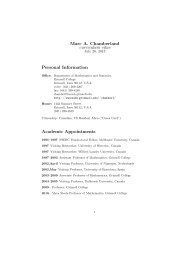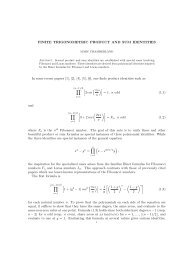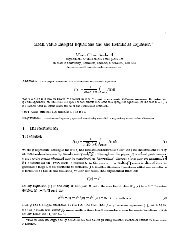An Update on the 3x+1 Problem Marc Chamberland Contents
An Update on the 3x+1 Problem Marc Chamberland Contents
An Update on the 3x+1 Problem Marc Chamberland Contents
You also want an ePaper? Increase the reach of your titles
YUMPU automatically turns print PDFs into web optimized ePapers that Google loves.
2<br />
1 Introducti<strong>on</strong><br />
The <strong>3x+1</strong> <strong>Problem</strong> is perhaps today’s most enigmatic unsolved ma<strong>the</strong>matical<br />
problem: it can be explained to child who has learned how to divide by 2<br />
and multiply by 3, yet <strong>the</strong>re are relatively few str<strong>on</strong>g results toward solving it.<br />
Paul Erdös was correct when he stated, “Ma<strong>the</strong>matics is not ready for such<br />
problems.”<br />
The problem is also referred to as <strong>the</strong> 3n + 1 problem and is associated with<br />
<strong>the</strong> names of Collatz, Hasse, Kakutani, Ulam, Syracuse, and Thwaites. It may<br />
be stated in a variety of ways. Defining <strong>the</strong> Collatz functi<strong>on</strong> as<br />
⎧<br />
⎨ 3x + 1 x ≡ 1 (mod 2)<br />
C(x) =<br />
⎩ x<br />
2<br />
x ≡ 0 (mod 2),<br />
<strong>the</strong> c<strong>on</strong>jecture states that for each m ∈ Z + , <strong>the</strong>re is a k ∈ Z +<br />
such that<br />
C (k) (m) = 1, that is, any positive integer will eventually iterate to 1. Note that<br />
an odd number m iterates to 3m + 1 which <strong>the</strong>n iterates to (3m + 1)/2. One<br />
may <strong>the</strong>refore “compress” <strong>the</strong> dynamics by c<strong>on</strong>sidering <strong>the</strong> map<br />
⎧<br />
⎨ <strong>3x+1</strong><br />
2<br />
x ≡ 1 (mod 2)<br />
T (x) =<br />
⎩ x<br />
2<br />
x ≡ 0 (mod 2).<br />
The map T is usually favored in <strong>the</strong> literature.<br />
To a much lesser extent some authors work with <strong>the</strong> most dynamically<br />
streamlined 3x + 1 functi<strong>on</strong>, F : Z + odd → Z+ , defined by<br />
odd<br />
F (x) = 3x + 1<br />
2 m(<strong>3x+1</strong>)<br />
where m(x) equals <strong>the</strong> number of factors of 2 c<strong>on</strong>tained in <strong>3x+1</strong>. While working<br />
with F allows <strong>on</strong>e to work <strong>on</strong>ly <strong>on</strong> <strong>the</strong> odd positive integers, <strong>the</strong> variability of<br />
m seems to prohibit any substantial analysis.<br />
This survey reflects <strong>the</strong> author’s view of how work <strong>on</strong> this problem can<br />
be structured. I owe a huge debt to Jeff Lagarias and Gün<strong>the</strong>r Wirsching for<br />
<strong>the</strong> important work <strong>the</strong>y have d<strong>on</strong>e in bringing this problem forward.<br />
paper of Lagarias[45](1985) thoroughly catalogued earlier results, made copious<br />
The





